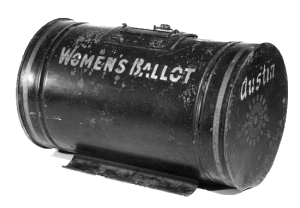Passage 1 (Q.1-6)

At the Seneca Falls Convention in 1848,
women had called for the right to vote. After
the Civil War, Congress passed the Fifteenth
Amendment, giving voting rights to
- freedmen, but not to women. Some leading
abolitionists became suffragists, men and
women who fought for woman suffrage or
women’s right to vote. Like other reformers,
the suffragists formed organizations to
- promote their cause. Elizabeth Cady Stanton
and Susan B. Anthony founded the National
Woman Suffrage Association, which called for
a constitutional amendment allowing women
to vote in national elections. A second
- organization, the American Woman Suffrage
Association, focused on winning woman
suffrage in state elections. In 1890 the two
groups merged to form the National
American Woman Suffrage Association. Led
- by Anna Howard Shaw, a minister and doctor,
and Carrie Chapman Catt, a newspaper editor
and educator, this organization grew to more
than two million members by 1917. Groups
formed to protest the idea of giving women
- the vote. Both men and women supported
these groups on the belief that woman
suffrage would disturb society’s “natural”
balance and result in divorce and neglected
children.
- The suffragists won their early victories in the
West. Wyoming led the nation in giving
women the right to vote in 1890. Between
1910 and 1913, five other states adopted
woman suffrage. By 1919 women could vote
- in at least some elections in most of the 48
states. In the meantime, suffragists continued
their struggle to win the vote everywhere.
Alice Paul, a Quaker who founded the
National Woman’s Party in 1916, was a
- forceful leader of the suffragist movement.
She sought greater economic and legal
equality as well as suffrage for women. During
a visit to Great Britain, Paul saw suffragists
use protest marches and hunger strikes to call
- attention to their cause. When she returned to
the United States, she too used these methods
in the fight for suffrage. In 1917, Alice Paul
met with President Woodrow Wilson but
failed to win his support for woman suffrage.
- Paul responded by leading women protesters
in front of the White House. Day after day
they marched carrying banners demanding
votes for women. When Paul and other
demonstrators were arrested for blocking the
- sidewalk, they started a much-publicized
hunger strike. Alva Belmont, one of the
protestors, proudly declared that all the
women had done was to stand there “quietly,
peacefully, lawfully, and gloriously.”
- By 1917 the national tide was turning in favor
of woman suffrage. New York and, a year
later, South Dakota and Oklahoma granted
equal suffrage. Meanwhile, Congress began
debating the issue, and President Wilson
- agreed to support an amendment to the
Constitution. Finally, in 1919 the Senate voted
in favor of the Nineteenth Amendment,
which allowed for women’s suffrage. The
amendment was ratified in 1920, in time for
- women to vote in that year’s presidential
election. For the first time, American women
were able to participate in the election of their
national leaders.
Passage 2 (Q.7-12)

After radical politics drove David Alfaro
Siqueiros from his native country in 1932, the
famous Mexican muralist was commissioned
to paint an 80-foot broad fresco on the newly
- formed Olvera Street in the idyllic Old
Mexico neighborhood of downtown Los
Angeles. Promoters envisioned colorful birds
and lush rainforests in the new painting,
“América Tropical,” to celebrate Tropical
- American culture. Siqueiros painted the
mural’s first two sections, depicting a tropical
rainforest and a Maya pyramid, in the daylight.
However, to avoid scrutiny, Siqueiros painted
the final section of the mural, the centerpiece,
- at night.
When Siqueiros unveiled the mural, the
reason for his secrecy became clear. The
central image of the work was a horrific figure
of a Mexican native crucified on a double
- cross as an American eagle perched above
him. Siqueiros’ symbolic indictment of
imperialism clashed with the idyllic Old
Mexico portrayed on the street below.
Displeased, the people who commissioned the
- painting painted over a part of the mural
almost immediately, and the entire fresco was
whitewashed by 1938.
Exposure to decades of sun and rain caused
the white paint covering the outdoor mural to
- fade by 1971 revealing the bright colors
underneath. At the same time, artists raising
awareness of Mexican American cultural
identity began to rediscover various works of
the Mexican muralists like Diego Rivera, José
- Clemente Orozco, and David Siqueiros.
“América Tropical” celebrated Mexican
American heritage while at the same time
making a political statement. Inspired by
Siqueiros’ whitewashed emblem of social
- justice, a new generation of artists embraced
“Mexican Muralism.”
The resulting Chicano mural movement
gained steam throughout California and the
Southwest United States in the 1970s.
- Hundreds of huge, brilliant new murals
depicting Mexican American culture and
history appeared during this period, some
commissioned in cultural locations but most
painted in abandoned lots, on empty
- buildings, or on highways. Several of these
murals remain, although poorly maintained.
Fortunately, a new group of artists has
worked assiduously to resurrect and restore
many of these murals. Leading the way, eighty
- years to the day after its original unveiling,
Siqueiros’ “América Tropical” was restored
and once again revealed to the public.
Advocates anticipate that Siqueiros’ mural will
serve both as an inspiration and a lesson. In
- the words of the master who created this
important cultural and artistic legacy, “We
could not lie by painting a false Tropical
America; we had to paint the true, authentic
Tropical America.”
Subscriber grade and assessment reports are saved for future access. Exams and walkthroughs are available in printable PDF format for offline test prep.
